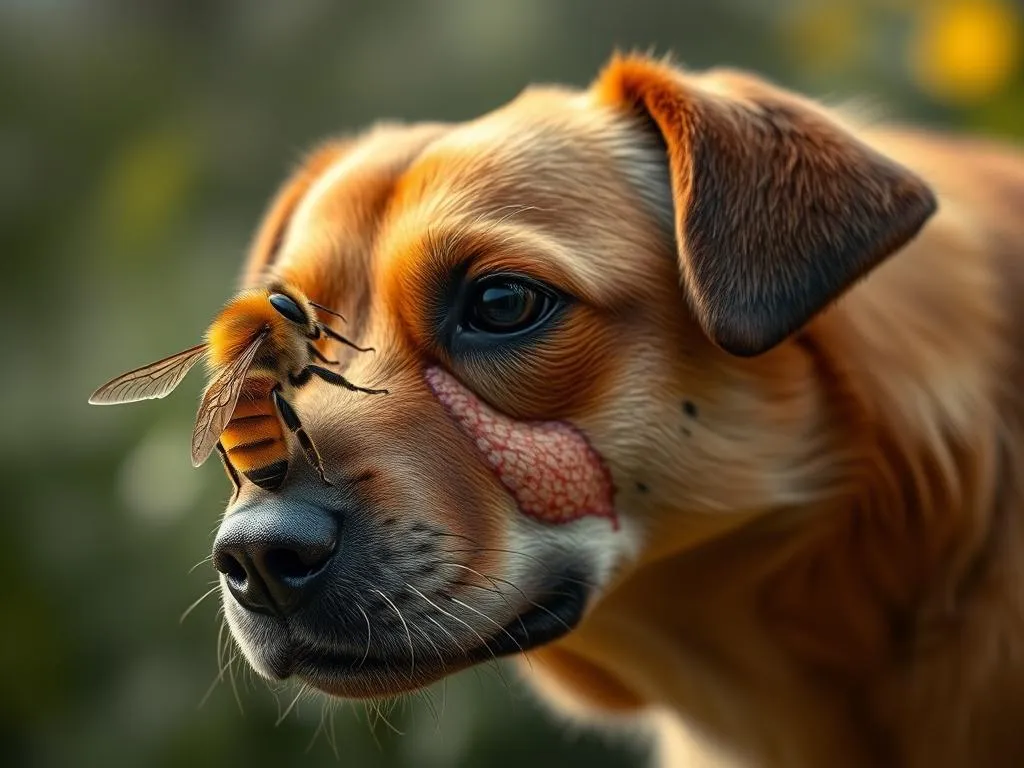
Bee stings can be a distressing experience for both dogs and their owners. Understanding the implications of a bee sting is crucial for every pet parent, especially when it comes to identifying potential symptoms and knowing how to respond. This guide aims to clarify what happens when your dog gets stung by a bee, the symptoms to look out for, and the best practices for treatment and prevention.
Understanding Bee Stings in Dogs
What Happens When a Dog Gets Stung?
When a dog gets stung by a bee, the insect injects venom through its stinger into the dog’s skin. The venom contains proteins that can affect the dog’s skin cells and immune system, leading to inflammatory responses. Honeybees, bumblebees, and wasps all have different venom compositions, which can influence how a dog reacts. Honeybees, for instance, leave their stinger behind, continuing to release venom even after they fly away, while wasps can sting multiple times.
Common Locations for Bee Stings
Typically, dogs are stung in areas that are more exposed or sensitive. The most common locations for bee stings in dogs include:
- Mouth: Dogs often investigate flowers or buzzing insects with their mouths, leading to stings.
- Paws: A curious dog might step on a bee resting on the ground.
- Face: Dogs may also get stung on the nose or face while sniffing around.
Factors like playful behavior and curiosity often increase the likelihood of a bee sting, especially during outdoor activities in spring and summer.
Symptoms of a Bee Sting
Immediate Reactions
After a bee sting, the first signs to look out for include:
- Swelling and redness: The area around the sting may become swollen and red.
- Pain and discomfort: Your dog might show signs of pain, such as whining or licking the area.
Severe Symptoms to Watch For
While many dogs may experience mild reactions, some can have severe symptoms indicating an allergic reaction:
- Hives: Raised welts on the skin can appear suddenly.
- Difficulty breathing: If your dog struggles to breathe, it may indicate a serious reaction.
- Anaphylaxis: This life-threatening condition can develop quickly and is characterized by severe swelling, a rapid drop in blood pressure, and loss of consciousness.
Mild vs. Severe Reactions
It’s essential to differentiate between mild and severe reactions. Mild symptoms usually include localized swelling and discomfort, while severe reactions can escalate quickly. Monitoring your dog closely for any changes in behavior or physical condition is crucial after a sting.
First Aid for Bee Stings
Initial Response Steps
If your dog gets stung, take immediate action:
- Check for Stinger Presence: If the stinger is still embedded in the skin, remove it gently using a pair of tweezers or the edge of a credit card. Avoid pinching the stinger, as this may release more venom.
- Clean the Area: Use mild soap and water to clean the sting site. This helps prevent infection.
Home Remedies
After initial care, consider these home remedies:
- Ice Packs: Applying an ice pack to the affected area can help reduce swelling and numb the pain. Wrap ice in a cloth and apply for 10-15 minutes.
- Natural Antihistamines: Ingredients like oatmeal or aloe vera can soothe the skin and reduce irritation.
When to Contact Your Veterinarian
You should seek veterinary advice if:
- Your dog shows severe symptoms like difficulty breathing or swelling around the face and neck.
- There are multiple stings, especially if they are concentrated in one area.
- Symptoms worsen or do not improve after initial care.
Treatment Options
At-Home Care
For mild reactions, you can manage your dog’s discomfort at home:
- Pain Relief Methods: Over-the-counter antihistamines like Benadryl may help reduce swelling and itching, but consult your vet for the correct dosage.
- Monitoring Behavior: Keep an eye on your dog for any changes in behavior, appetite, or energy levels.
Veterinary Treatments
If your dog requires professional help, your veterinarian may prescribe:
- Medications: Steroids and antihistamines can alleviate swelling and allergic reactions.
- Severe Reaction Treatments: In cases of anaphylaxis, immediate interventions such as epinephrine injections may be necessary.
Recovery and Aftercare
After treatment, follow these recovery tips:
- Follow-Up Care: Attend any scheduled follow-ups and follow your vet’s advice closely.
- Monitor for Secondary Infections: Watch for signs of infection, such as increased redness, swelling, or discharge from the sting site.
Preventing Bee Stings
Training and Behavior Modification
To reduce the risk of bee stings:
- Teach Your Dog to Avoid Bees: Training commands like “leave it” can help your dog avoid bees and other insects.
- Leash Training: Keep your dog on a leash in areas known for bee activity, especially near flowers or gardens.
Environmental Considerations
Consider these tips to create a safer environment:
- Avoid Areas with High Bee Populations: Be cautious in areas where bees are known to swarm, especially during warmer months.
- Identify and Remove Bee Nests: If you notice bee nests near your home, consider contacting pest control for safe removal.
Protective Gear
In certain situations, protective gear can help:
- Dog Bee Suits: Specialized suits can protect your dog from bee stings during outdoor activities.
- Protective Spray: Some sprays can deter bees, but always ensure they are safe for pets.
FAQs
Can bee stings be fatal to dogs?
While bee stings can lead to severe allergic reactions, fatalities are rare. However, dogs with known allergies are at a higher risk. Quick intervention is crucial in these cases to avoid complications.
What should I do if my dog is stung multiple times?
If your dog is stung multiple times, contact your veterinarian immediately, as the risk of severe reactions increases with the number of stings. Your vet may recommend treatments based on your dog’s condition.
Are some dogs more susceptible to bee stings?
Certain breeds may have predispositions to allergic reactions, but individual health factors like age, existing allergies, and overall health play significant roles. Always consult your vet if you have concerns about your dog’s susceptibility.
Conclusion
Understanding what to do if my dog got stung by a bee is essential for all pet owners. By recognizing symptoms, knowing first aid steps, and implementing preventive measures, you can safeguard your dog from the potential dangers of bee stings. Always prioritize responsible pet ownership, and don’t hesitate to seek veterinary help when needed. Your dog’s health and safety are worth the extra caution.









